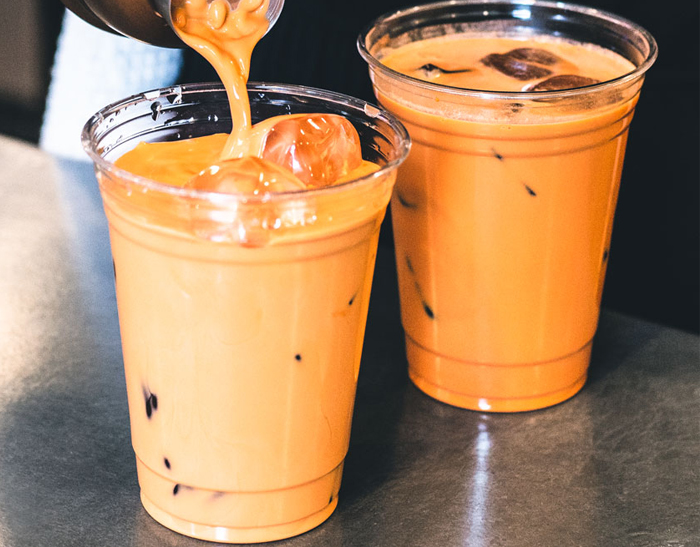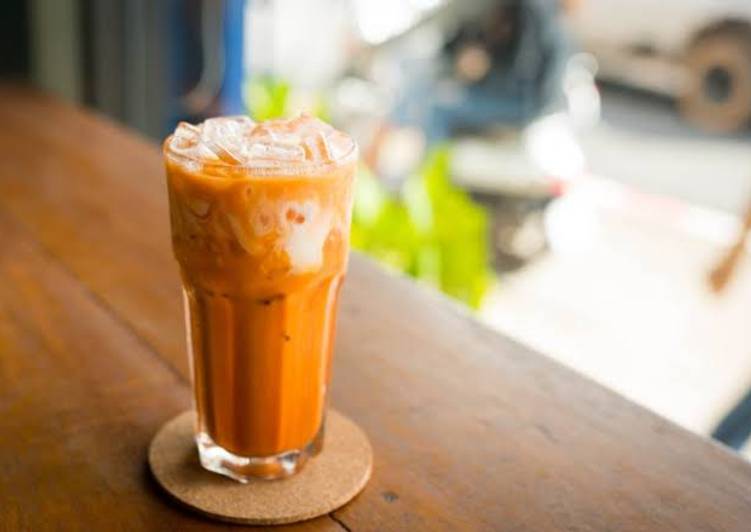Thai tea, a vibrant and aromatic beverage, has captivated tea enthusiasts worldwide. Originating in Thailand, this sweet and creamy tea is a beloved staple in Thai cuisine and a testament to the country’s rich culinary heritage. With its unique blend of spices and flavors, Thai tea offers a delightful escape into the vibrant streets of Thailand.
In this comprehensive guide, we will embark on a culinary journey to explore the secrets of making authentic Thai tea. We will delve into the essential ingredients, unravel the step-by-step preparation process, and uncover the variations and cultural significance that make this tea so extraordinary.
Join us as we unveil the enchanting world of Thai tea, where every sip promises a taste of Thailand’s vibrant spirit.
Ingredients
To prepare authentic Thai tea, you’ll need a blend of ingredients that harmonize together to create its signature taste and aroma.
The core components of Thai tea can be categorized into the following groups:
Tea Leaves
The foundation of Thai tea lies in the premium black tea leaves used. These leaves undergo a unique oxidation process that gives Thai tea its distinctive amber color and robust flavor.
- Assam tea leaves: Known for their full-bodied flavor and malty notes.
- Ceylon tea leaves: Offering a brighter, more citrusy profile.
- Chinese black tea leaves: Contributing a smoky and earthy dimension.
Preparation
Thai tea preparation involves brewing, adding sweeteners and spices, and straining the mixture. Let’s explore each step in detail:
Brewing the Tea
1. Place 4 cups of water in a large pot and bring it to a boil. 2. Add 1/2 cup of Thai tea leaves to the boiling water. 3. Reduce heat to low and simmer for 15 minutes.
4. Remove the pot from heat and let the tea steep for an additional 15 minutes.
Adding Sweeteners and Spices
1. Strain the brewed tea into a clean pot. 2. Add 1/2 cup of condensed milk and 1/4 cup of sugar to the tea. 3. Stir until the sweeteners are dissolved. 4. Add 1 teaspoon of ground star anise and 1/2 teaspoon of ground cinnamon to the tea.
5. Stir to combine.
Straining the Mixture
1. Pour the tea mixture through a fine-mesh sieve into a serving pitcher. 2. Serve the tea hot or cold, with ice if desired.
Variations

Thai tea is a versatile beverage that can be enjoyed in various forms. Here are some popular variations:
To create these variations, simply adjust the ingredients and proportions of the original Thai tea recipe. For example, to make iced Thai tea, brew the tea as usual and let it cool completely. Then, pour it over ice and add your desired amount of condensed milk and sweetener.
Thai Tea Latte
A Thai tea latte is a creamy and indulgent variation that combines Thai tea with steamed milk. To make a Thai tea latte, brew the tea as usual and let it cool slightly. Then, heat your milk in a saucepan or microwave until it is just simmering.
Pour the tea into a mug and top it off with the steamed milk. Add condensed milk and sweetener to taste.
Thai Tea Smoothies
Thai tea smoothies are a refreshing and flavorful way to enjoy Thai tea. To make a Thai tea smoothie, blend together Thai tea, condensed milk, sweetener, and your choice of fruit or yogurt. You can also add ice for a thicker smoothie.
Serving
Thai tea is traditionally served hot or iced, in a tall glass with plenty of ice. It can also be served as a float, with a scoop of ice cream on top.
Garnishes for Thai tea include:
- Fresh or dried orange peel
- Star anise
- Cinnamon sticks
- Mint leaves
Accompaniments for Thai tea include:
- Sweetened condensed milk
- Sugar
- Coconut milk
- Tapioca pearls
Variations
In addition to the traditional way of serving Thai tea, there are several creative variations that can be made.
One variation is to make a Thai tea latte. To make a Thai tea latte, simply add steamed milk to your Thai tea. You can also add flavored syrups, such as vanilla or caramel, to your Thai tea latte.
Another variation is to make a Thai tea smoothie. To make a Thai tea smoothie, simply blend Thai tea with fruit, yogurt, and ice.
Health Benefits

Thai tea offers a range of potential health benefits attributed to its unique blend of ingredients. These ingredients, including black tea, spices, and condensed milk, contribute to its antioxidant properties, anti-inflammatory effects, and potential role in supporting digestive health.
Antioxidant Properties
Thai tea contains a high concentration of antioxidants, primarily from the black tea leaves used in its preparation. Antioxidants help protect cells from damage caused by free radicals, unstable molecules that can contribute to chronic diseases. Studies have shown that regular consumption of black tea may reduce the risk of certain types of cancer, cardiovascular disease, and neurodegenerative disorders.
Cultural Significance
Thai tea, known locally as “cha yen,” holds a deep cultural significance in Thailand. Its popularity extends beyond its delicious taste, becoming an integral part of Thai society and everyday life.
History and Popularity
Thai tea traces its origins to the early 20th century when King Rama V introduced tea drinking to the country. Over time, Thai tea evolved from a royal beverage to a national favorite, enjoyed by people from all walks of life.
Today, it is ubiquitous in Thailand, found in homes, street stalls, and restaurants.
Last Recap
Our exploration of Thai tea has taken us on a flavorful adventure, revealing the intricacies of its preparation, variations, and cultural significance. Whether enjoyed as a refreshing iced beverage or a comforting warm drink, Thai tea has become an iconic symbol of Thailand’s culinary prowess.
As you embark on your own Thai tea-making journey, may this guide serve as your trusted companion. Remember, the true essence of Thai tea lies in the love and care poured into its creation. So gather your ingredients, embrace the flavors, and let the vibrant spirit of Thailand infuse your cup.
Helpful Answers
What is the secret to achieving the perfect balance of sweetness and creaminess in Thai tea?
The key to balancing sweetness and creaminess lies in adjusting the amount of condensed milk added. Start with a small amount and gradually add more until you reach your desired taste. Additionally, using high-quality tea leaves and spices will enhance the overall flavor profile.
Can I use regular milk instead of condensed milk in Thai tea?
Yes, you can substitute regular milk for condensed milk. However, condensed milk provides a thicker, sweeter, and creamier texture. If using regular milk, you may need to adjust the sweetness by adding sugar or honey to taste.
How can I make Thai tea without using a tea bag or strainer?
If you don’t have a tea bag or strainer, you can use a cheesecloth or a fine-mesh sieve to strain the tea leaves. Simply place the tea leaves in the cheesecloth or sieve and dip it into the boiling water.
Steep for the desired time, then remove the cheesecloth or sieve and discard the tea leaves.
